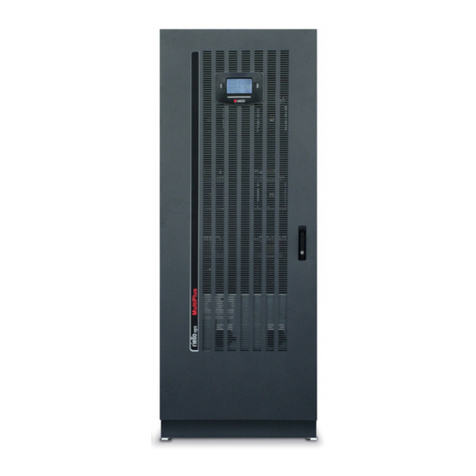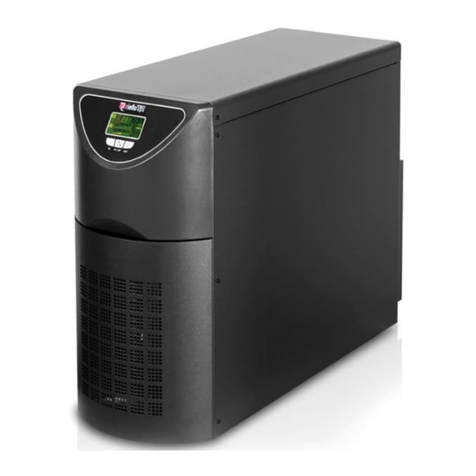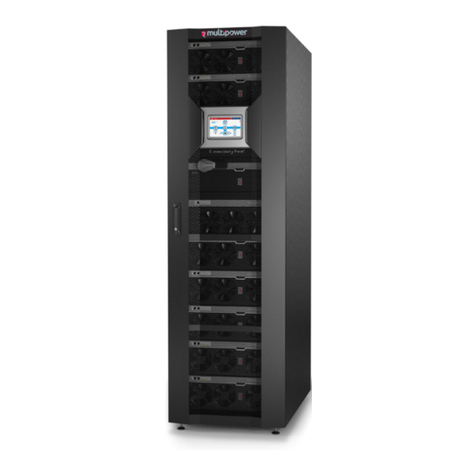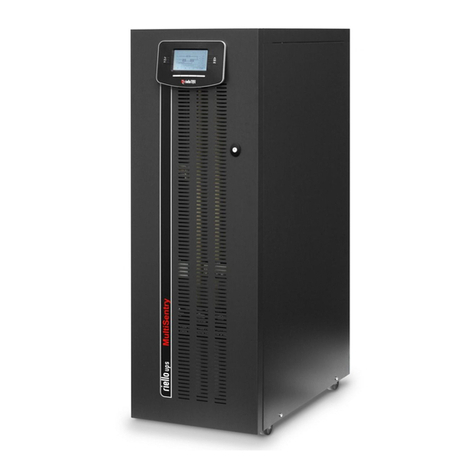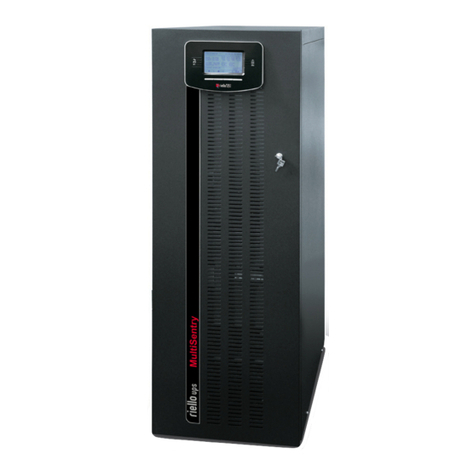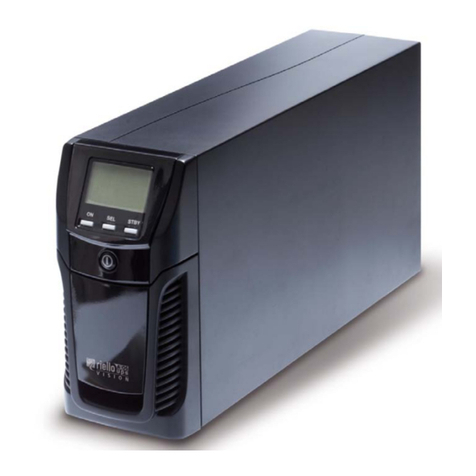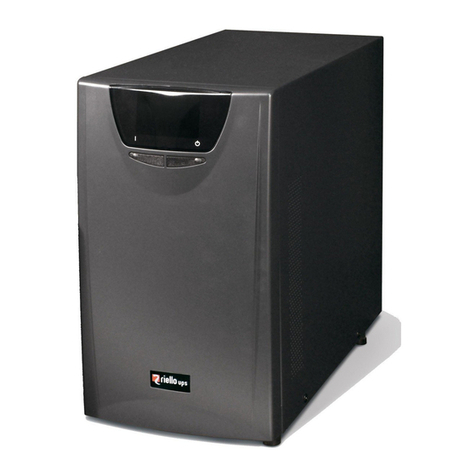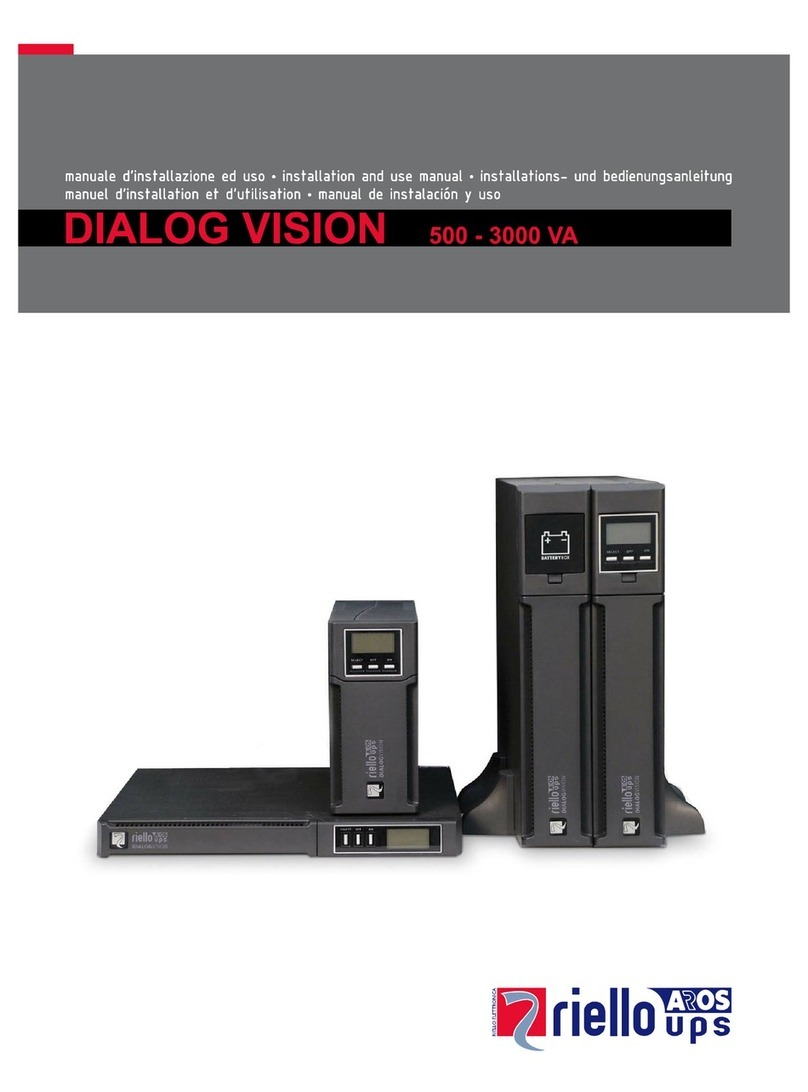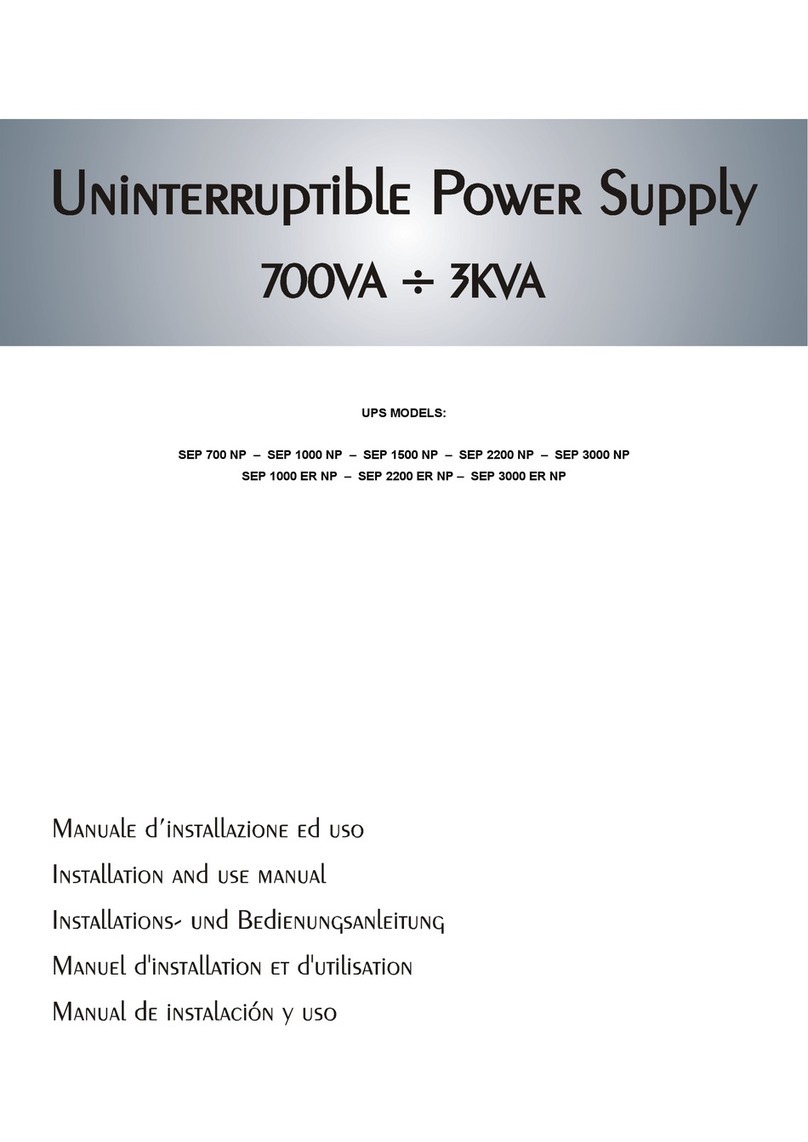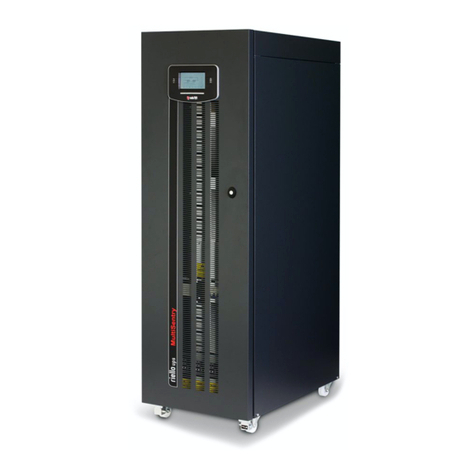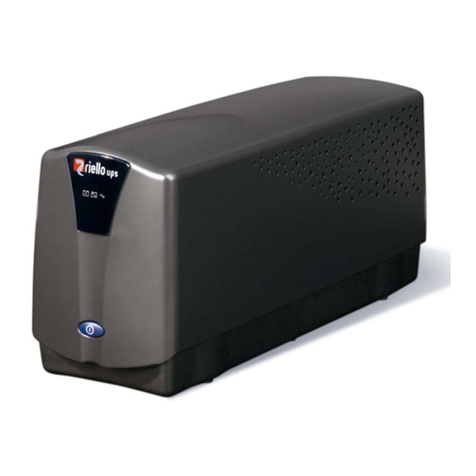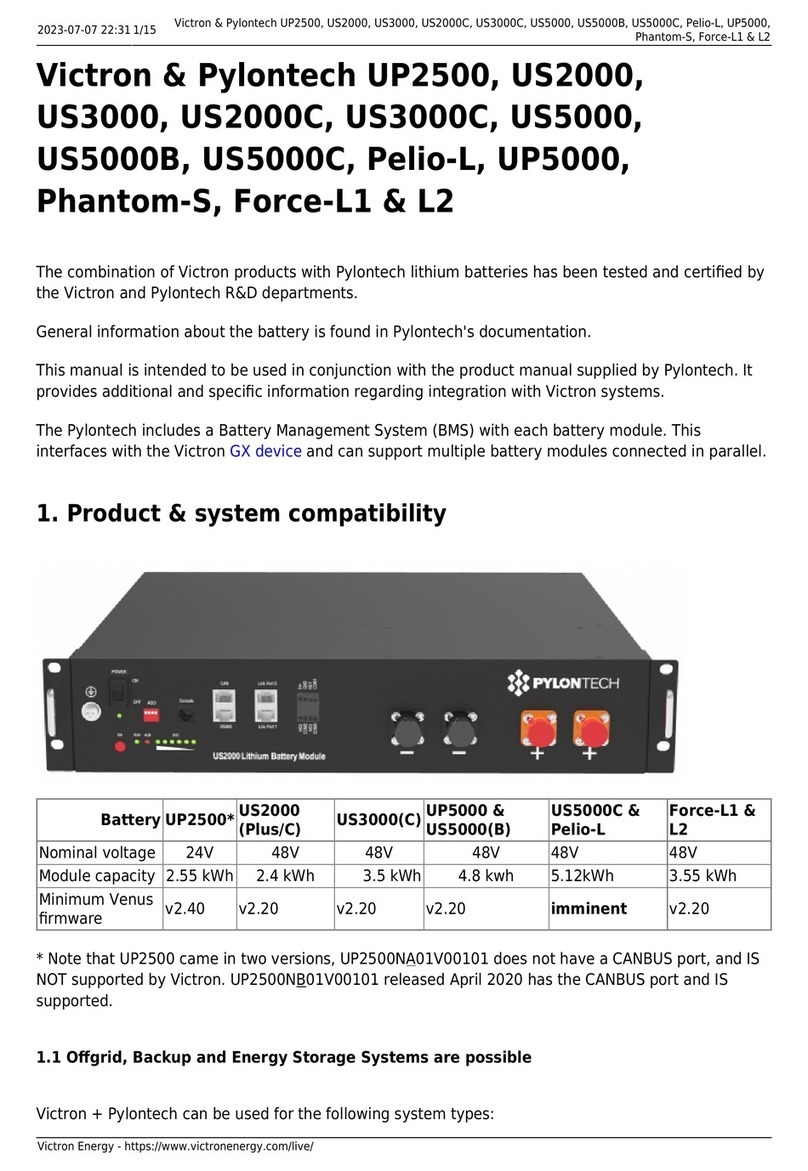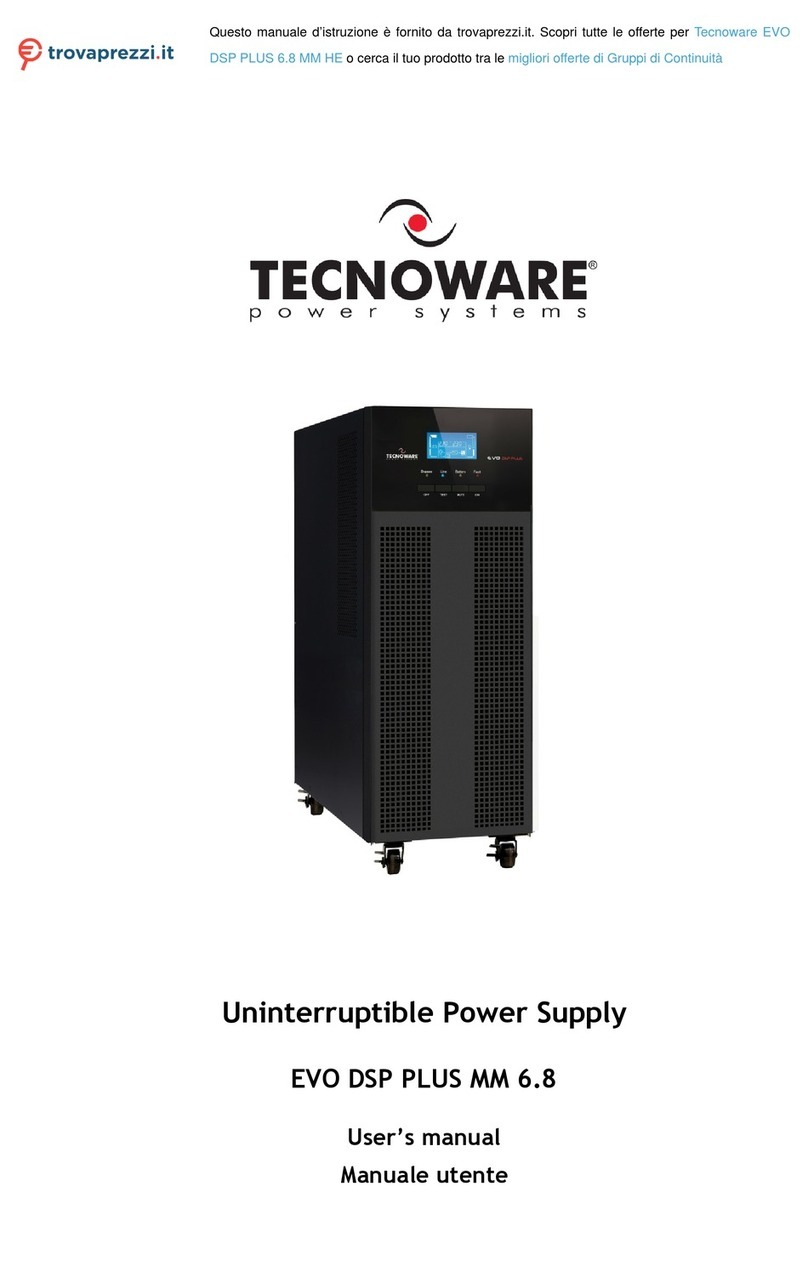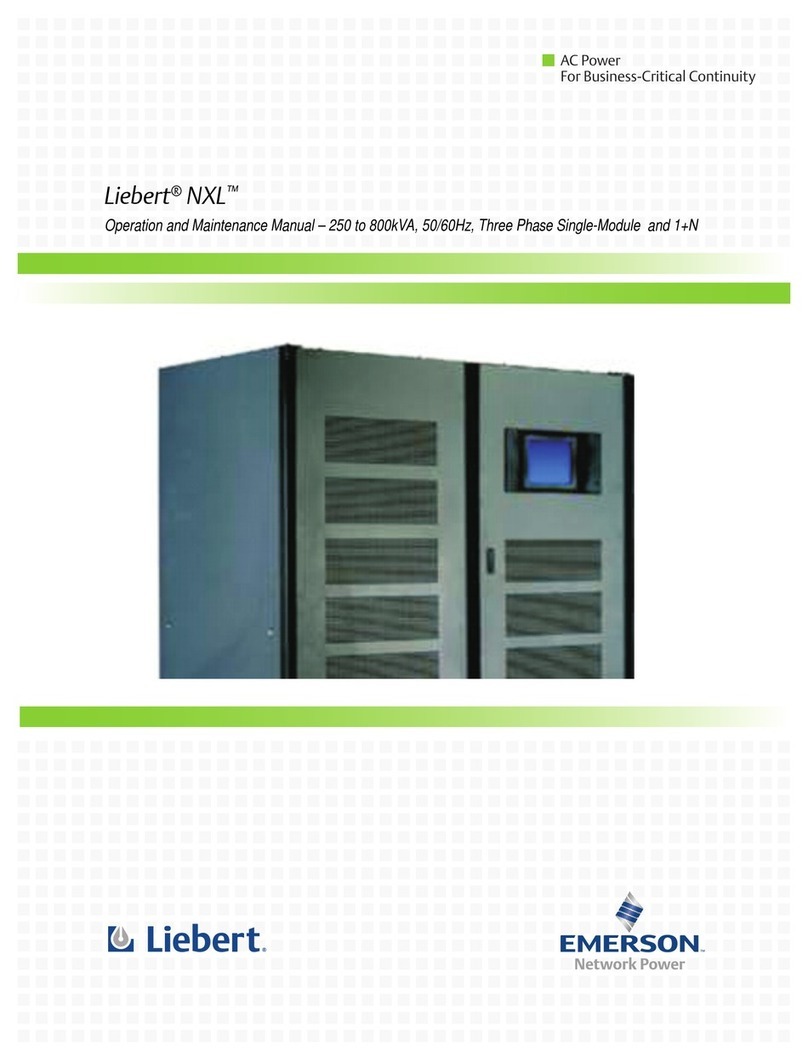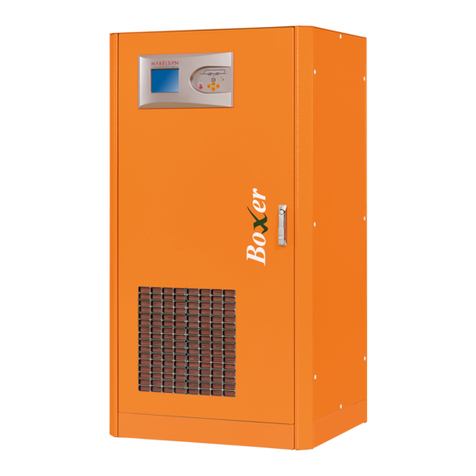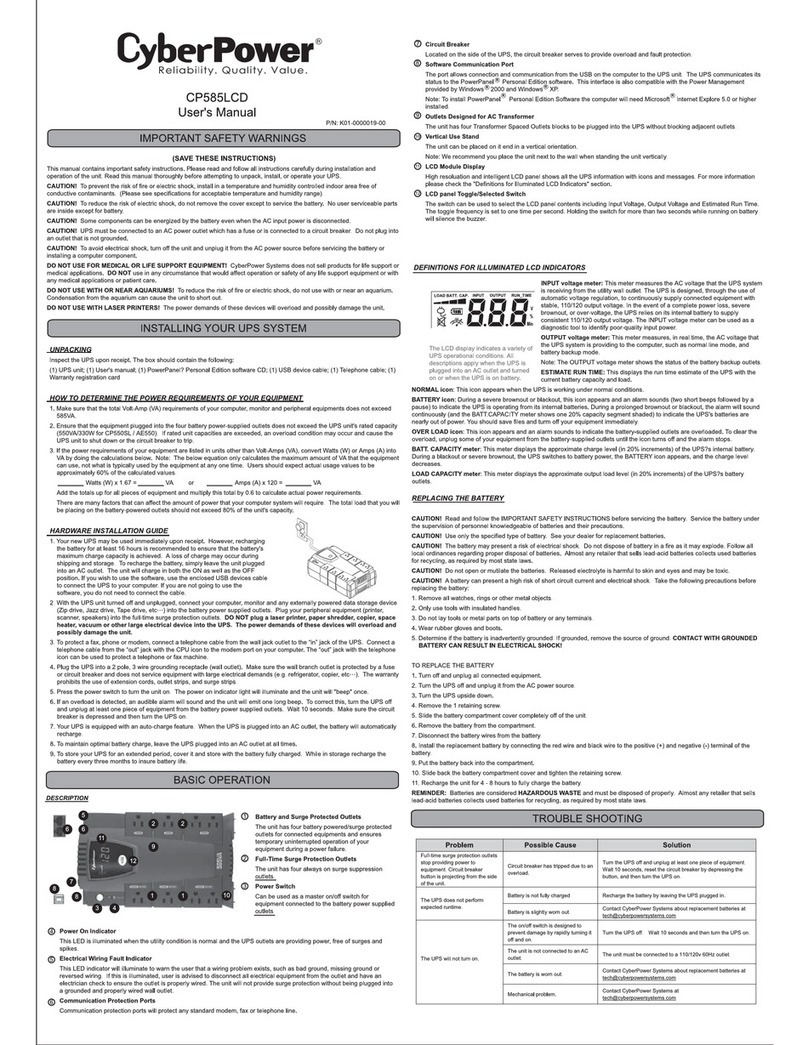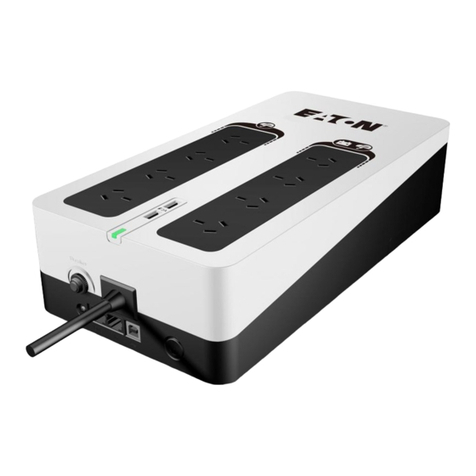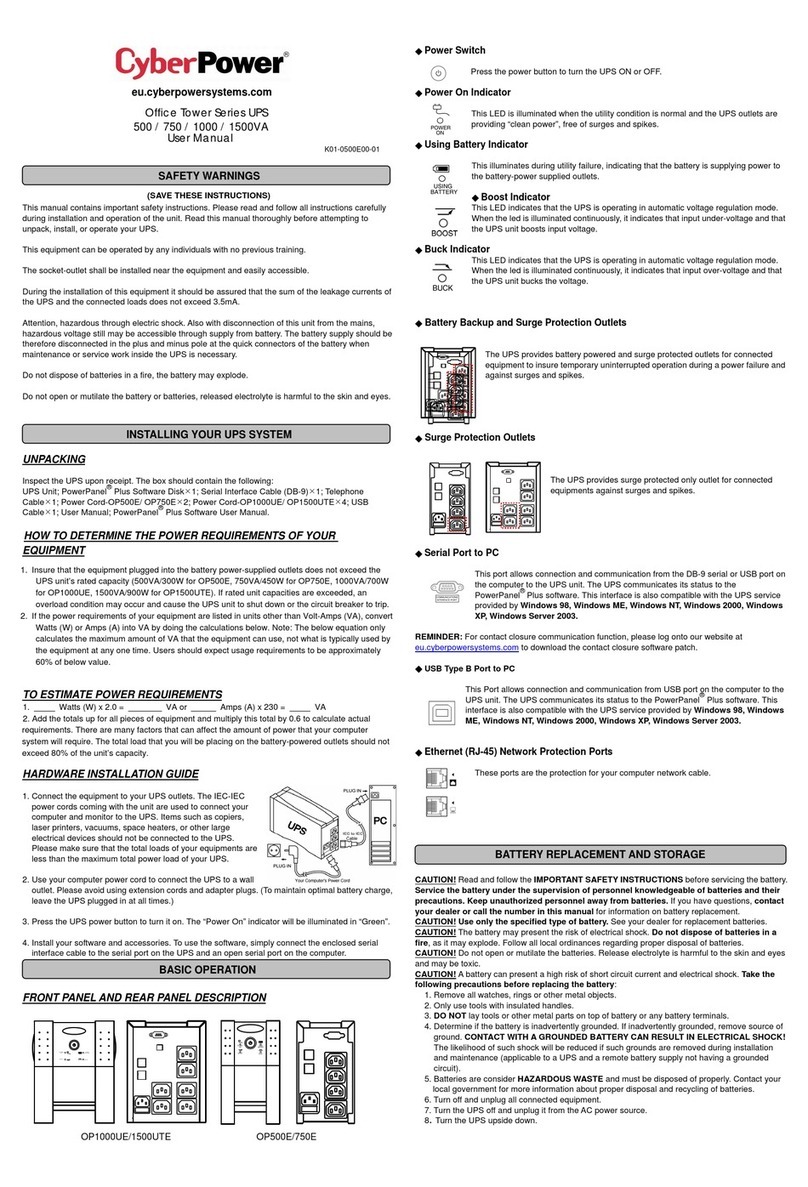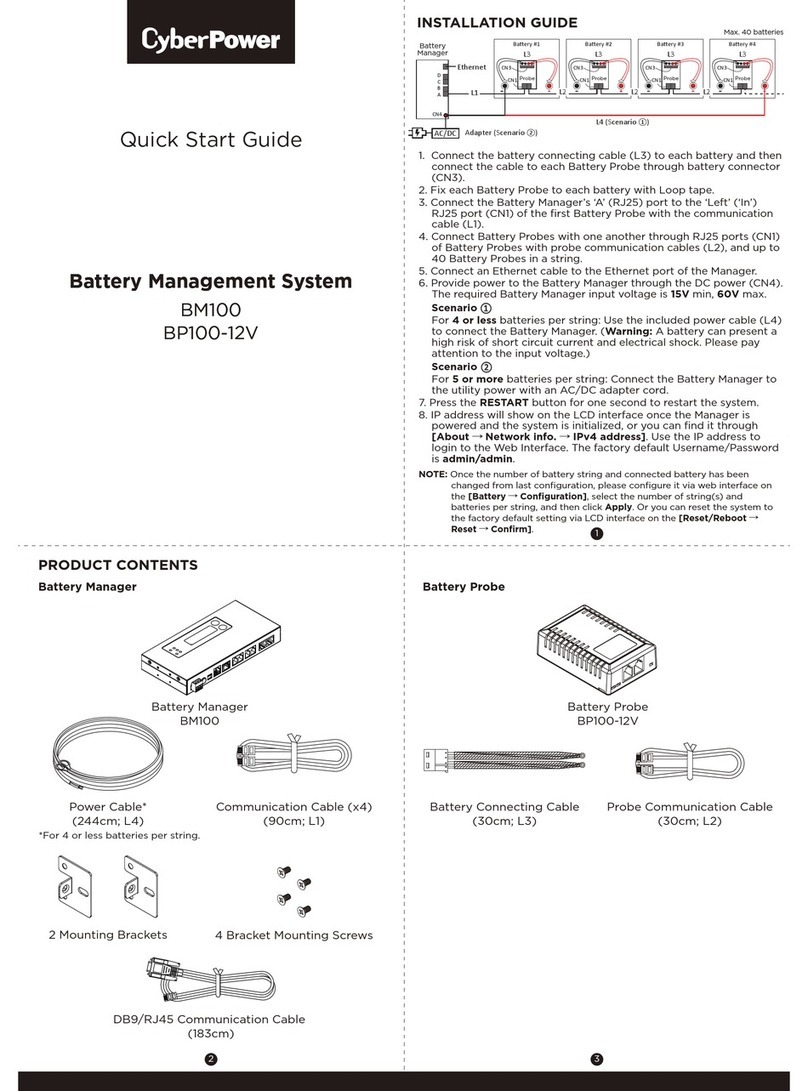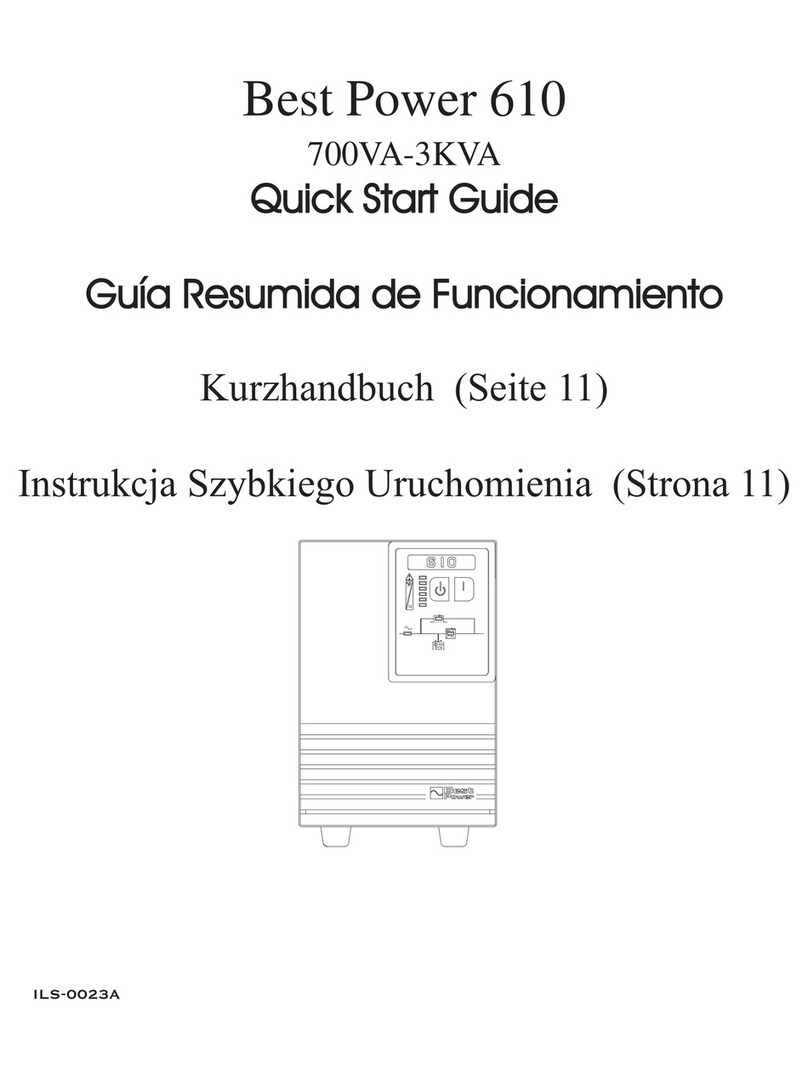TROUBLESHOOTING
PROBLEM POSSIBLE
CAUSE PROCEDURE
The UPS does not
switch on
The UPS is switched
off Check that the STAND-BY/ON switch is in the ON
position
The UPS input thermal
protection device has
been triggered
Disconnect non-essential equipment fromthe UPS.
Reset the protection (11) by depressing the button. If
the switch resets, start up the UPS and reconnect the
equipment one device at a time. If the protection
activates again, one of the connected devices is
causing an overload condition.
The UPS is working on
battery even though
mains power is
available
The UPS input
thermal protection
device has been
triggered
Disconnect non essential equipment from the UPS.
Reset the protection (11) by depressing the button.
The mains power
supply socket the UPS
is connected to is not
supplying power to the
device
Connect the UPS to another mains power supply
socket or have the mains supply checked by a
qualified electrician.
When there is a mains
power supply failure,
the UPS does not work
for the expected
runtime
The UPS battery is
not sufficiently
charged as there was
not enough time for it
to recharge after a
recent power failure
Wait for the battery to recharge. It recharges each time
the UPS is connected to a mains socket. It usually
takes 8 hours for the battery to recharge fully. UPS
operation time is a function of how charged the
battery is.
The battery needs to
be replaced. Replace the battery.
The alarm icon (3) is lit
and the acoustic signal
sounds. The UPS has a fault.
Remove the external devices from the UPS. Turn off
the UPS and disconnect it from the mains. Connect
the UPS to the mains and turn on again. If the UPS
message the anomaly again, contact your authorized
service centre.
Battery fault message. Battery fault. Replace the battery.
The UPS is not
communicating with a
PC.
The software sends a
message that
communication has
been lost.
Check that the USB cable is connected between the
UPS and the PC and that ‘USB’ has been selected as
the communication port in the software configuration.
The software is not
installed Install the specific software for your computer’s
operating system.
TECHNICAL DATA
MODEL 600VA 800VA
INPUT
Volta g e 230V +20%/ -25%
Frequency 50 or 60Hz +/-5% (with auto-sensing)
OUTPUT
Voltage (from battery) 230Vac +/-10% (Pseudo-sinusoidal wave)
Frequency (from battery) 50 or 60Hz +/-1Hz (with auto-sensing)
Trigger time 2-6 ms typical
Rated power VA 600 800
Rated power W 360 480
SURGE
SOCKETS Max. current 5A 8A
PROTECTION
DEVICES AND
FILTERS
Overload and shortcircuit
protection
From mains: overload input protection.
From mains: automatic shutdown after 5 minutes with load
>110% and immediate shutdown with load >120% or for
shortcircuit.
From battery: automatic shutdown after 5seconds with load
>110% and immediate shutdown with load >120% or for
shortcircuit.
BATTERY
Type Sealed lead batteries, maintenance-free
Model 12V 7Ah 12V 9Ah
Typical recharge time 6-8 hours
Protection Protection against total discharge, battery replacement
indicator
AMBIENT
CONDITIONS
Operating conditions Max altitude 6,000 m, 0-90% non condensing humidity,
0-40°C
VARIOUS
Noise <40dB (at 1m from source)
Earth leakage current <1mA
RISOLUZIONE PROBLEMI
PROBLEMA POSSIBILE
CAUSA PROCEDURA
L’UPS non si accende.
L’UPS è spento. Verificare che l’interruttore STAND-BY/ON sia in
posizione ON.
È scattata la protezione
d’ingresso dell’UPS.
Scollegare gli apparecchi non essenziali dall'UPS.
Ripristinare la protezione (11) premendo il relativo
pulsante fino al blocco. Accendere l'UPS e ricollegare
gli apparecchi uno alla volta. Se la protezione
interviene di nuovo, probabilmente uno degli
apparecchi collegati è la causa del sovraccarico.
L'UPS funziona da
batteria sebbene sia
disponibile la rete
elettrica.
È scattata la protezione
d’ingresso dell'UPS.
Scollegare gli apparecchi non essenziali dall'UPS.
Ripristinare la protezione (11) premendo il relativo
pulsante fino al blocco.
La presa di
alimentazione a cui è
collegato l’UPS non
fornisce alimentazione al
dispositivo.
Collegare l'UPS a un’altra presa di alimentazione o far
controllare l’impianto di rete da un elettricista
qualificato.
Quando si verifica un
guasto della rete
elettrica l'UPS non
funziona per il periodo
di tempo previsto.
La batteria dell'UPS non
è adeguatamente carica
in quanto non ha avuto il
tempo di ricaricarsi dopo
una recente mancanza
della rete elettrica.
Attendere che la batteria si ricarichi. La ricarica
avviene ogni qualvolta l'UPS è collegato a una presa di
alimentazione. In genere occorrono 8 ore per ricaricare
completamente la batteria. Il tempo di funzionamento
dell'UPS da batteria è ridotto finché la batteria non è
completamente carica.
La batteria è da
sostituire. Sostituire la batteria.
Il simbolo di allarme
(3) si accende e il
segnale acustico è
attivo.
L’UPS ha rilevato
un’anomalia.
Scollegare gli apparecchi dall’UPS. Spegnere l’UPS e
togliere l’alimentazione.Alimentare l’UPS e
riaccenderlo nuovamente. Se la segnalazione si
ripresenta rivolgersi al vostro centro di assistenza
autorizzato.
Si attiva la
segnalazione di
batteria guasta. Batteria guasta. Sostituire la batteria.
L’UPS non comunica
con il pc.
Il software manda un
messaggio di
comunicazione persa.
Controllare che il cavo USB sia collegato all’Ups e al
pc e che nella configurazione del software di
comunicazione sia selezionata USB come porta di
comunicazione.
Il software non è
installato Installare il software specifico per il sistema operativo
del vostro pc.
DATI TECNICI
MODELLO 600VA 800VA
INGRESSO
Tensione 230V +20%/ -25%
Frequenza 50 or 60Hz +/-5% (con autoapprendimento)
USCITA
Tensione (da batteria) 230Vac +/-10% (Onda pseudo sinusoidale)
Frequenza (da batteria) 50 or 60Hz +/-1Hz (con autoapprendimento)
Tempo di intervento Tipico 2-6 ms
Potenza nominale VA 600 800
Potenza nominale W 360 480
PRESE SURGE
Corrente max. 5A 8A
PROTEZIONE
Protezione sovraccarico e
cortocircuito
Da Rete: protezione d’ingresso per sovraccarico.
Da Rete: spegnimento automatico dopo 5 minuti con carico
>110% e immediato con carico >120% o con cortocircuito.
Da Batteria: spegnimento automatico dopo 5 secondi con
sovraccarico >110% ed immediato con sovraccarico >120% o
con cortocircuito.
BATTERIA
Tipo Sigillate, al piombo, senza manutenzione
Modello 12V 7Ah 12V 9Ah
Tempo di ricarica tipico 6-8 ore
Protezioni Protezione contro la scarica totale, indicatore di sostituzione
batteria
CONDIZION I
AMBIENTALI
Condizioni operative Altitudine max 6,000 m, 0-90% di umidità non condensata, 0-
40°C
VA RI E
Rumorosità <40dB (a 1 m dalla sorgente )
Correnti di dispersione
verso terra <1mA
Thank you for choosing our product.
IMPORTANT SAFETY NOTES
This device can be installed by anyone, provided that they READ THIS MANUAL CAREFULLY
AND FOLLOW THE INSTRUCTIONS WITHIN IT.
This manual contains detailed instructions for the use and installation of the UPS.
This manual should be kept close to the UPS and READ BEFORE THE UPS IS INSTALLED
AND USED
© No part of this manual may be reproduced, even partially, without the manufacturer’s
authorisation. For purposes of improvements the manufacturer reserves the right to change
specifications at any time and without notice.
Warning:
Read the following instructions carefully and keep this manual handy for easy referral.
The mains power supply socket used to power the UPS must have an earth connection.
Potentially dangerous electrical voltages are generated inside this device, even when the UPS is
switched off. All repairs must be carried out by authorised personnel only.
Voltage may be present on the UPS output sockets even when the UPS is not connected to a mains
power supply.
In the event of a mains power supply failure (emergency UPS operation), do not unplug the power
supply cable to the UPS, to ensure earth continuity to the connected loads.
Do not allow liquids and/or other foreign bodies to enter the UPS.
Since the mains power supply cable acts as a separation device, the mains power supply socket
used that connects to the rear of the UPS must be accessible and easy to disconnect.
In dangerous conditions and/or to disconnect the UPS from sources of energy, (whether mains or
batteries), disconnect the power supply cable from the mains socket or from the back of the UPS
and shut down the UPS using the STAND-BY/ON switch (6).
Risk of electric shock. Since internal components are connected to the batteries, they will remain
powered, and therefore dangerous, even after the device has been disconnected from a mains power
supply. Disconnect the batteries and ensure no voltage is present before carrying out any repair or
maintenance operations.
The UPS generates an earth leakage current. Ensure that the sum of the UPS and load earth leakage
current is less than 3.5mA.
Replaced batteries should be considered as TOXIC WASTE and treated as such.
Do not throw the batteries into a fire.
Do not try to open the batteries: they do not requireany maintenance. Furthermore the electrolyte is
dangerous if it comes into contact with skin or eyes and may be toxic.
The batteries can cause electric shock and have a high short circuit current. Take the necessary
safety measures and precautions when handling them:
- do not wear watches, rings, necklaces or any other metallic material
- only use tools with insulated handles
Only use the UPS following the specific instructions in this user manual.
DESCRIPTION OF THE UPS
Front and rear views:
1. Back-up sockets (local type)
2. Surge sockets (local type)
3. /RED LED: various messages (see the “Alarms and Report Signals table”)
4. /YELLOW LED: the UPS operates on battery
5. /GREEN LED: the UPS operates from the mains power supply
6. Main STAND-BY/ON switch
7. Battery compartment locking screws
8. Battery compartment
9. Back-up sockets (IEC type)
10. USB port
11. Input protection device
12. Power supply cable
INSTALLATION
Opening of packing and verification of its contents
Remove the UPS from its packaging and check that there is no visible damage caused during
shipping. If there is any noticeable damage to the UPS, pack the product up and return to
where it was purchased.
Packing contents
¾UPS
¾User manual
¾Warranty card
Positioning
Follow the instructions below to correctly install and position the UPS:
¾The UPS must be placed on a horizontal surface.
¾The UPS must not be exposed to direct sunlight.
¾Ensure that the ambient temperature is between 0°C and 40°C, for optimal performance use
at a maximum temperature of 25°C.
¾The ambient humidity is less than 90%.
¾Avoid dusty environments.
¾Place the UPS at least 5cm from a wall to ensure adequate ventilation.
¾Ensure that the UPS or any other heavy object is clear of the power supply cable.
¾Ensure that the cables connecting loads to the UPS are not longer than 10metres.
Storage
The UPS must be fully recharged if it is to be stored for a long time. A full discharge and charge
cycle should be carried out every 6 months to keep the battery in good condition.
OPERATION
Connection to mains and battery charging
Please ensure that the mains power supply to be used with this UPS has upstream protection rated
at either 10A.
¾Connecting the UPS to the mains with the power supply cable provided.
¾The UPS will recharge its battery each time it is connected to a mains power supply (even if
it is powered down). We recommend that the UPS is charged for 6-8 hours before connecting
the loads.
Connecting the loads
After having loaded the UPS, loads can be connected (e.g.: computer, monitor, etc.) to the output
sockets, according to the following indications:
¾Back-up sockets (1) (9): these sockets are only powered when the UPS is on. Should mains
power fail, the back-up sockets are battery-powered.
N.B.: we recommend not running laser printers or laser print devices from back-up sockets
(1) (9) together with other computer peripheral equipment. On odd occasions, this equipment
uses a greater quantity of energy than when at rest. This set-up may lead to UPS overload and
cause all equipment connected to be switched off.
¾Surge sockets (2): additional filtered sockets limiting line surge and mains disturbances.
They do not protect the load from power failures or short blackouts. They can be used to
power non-essential devices such as, for example, printers, scanners and suchlike. Small
laser printer devices can be installed on these sockets.
N.B.: the sockets are also powered when the UPS is in stand-by.
Starting up/Shutting down
Press the main STAND-BY/ON switch to start-up the UPS and power the loads.
Press the switch again to shut down the UPS and power down from the loads.
Starting up on battery (Cold start)
If there is no mains power supply present, pressing the main power switch will cause the UPS to
start up using its battery as a source of power.
Warning: when starting up on battery, the output frequency is set to 50Hz.
USB port
The UPS can be connected to a computer for remote monitoring and shutdown operations using a
USB cable. The UPS management software and related manual can be downloaded from
www.riello-ups.com.
Replacing the batteries
CAUTION: The models require replacement by qualified service personnel.
Contact technical support for information concerning the exact model of battery to use.
-Shut down the UPS and disconnect the power cable. Remove the screws that hold the battery
compartment in place under the UPS. (Fig. A)
-After removing the cover, carefully remove the battery from its housing. (Fig. B)
-Disconnect the two wires from the battery (simply by pulling them). Replace the battery with
another of the same type, taking care to respect the polarity. Re-assemble the compartment. (Fig.
C)
ALARMS AND REPORT SIGNALS
Description Switch
position
(6)
Led functioning
Other report signals
Green led
Yellow led
Red led
Stand-by STAND-BY Blinking
Operation on mains
power ON Steady
Operation on battery ON Blinking Slow blinking acoustic
signal
End of discharge
warning ON Blinking Blinking acoustic signal
Overload ON Blinking Blinking acoustic signal
Battery fault ON Steady Steady Blinking acoustic signal
Alarm or fault (other
than overload) ON Steady
Continuous acoustic
signal
Vi ringraziamo per la scelta del nostro prodotto!
NOTE IMPORTANTI PER LA SICUREZZA
Questa apparecchiatura può essere installata da qualsiasi persona, previa ATTENTA E
SCRUPOLOSA LETTURA DEL PR ESENTE MANUALE.
Questo manuale contiene le istruzioni dettagliate per l’uso e l’installazione dell’UPS.
Per informazioni sull’utilizzo e per ottenere il massimo delle prestazioni dalla Vostra
apparecchiatura, il presente manuale dovrà essere conservato con cura vicino all’UPS e
CONSULTATO PRIMA DI OPERARE SULLO STESSO.
© E’ vietata la riproduzione di qualsiasi parte del presente manuale anche se parziale salvo
autorizzazione della ditta costruttrice. Per scopi migliorativi, il costruttore si riserva la facoltà di
modificare il prodotto descritto in qualsiasi momento e senza preavviso.
Attenzione:
Leggere con cura le seguenti istruzioni e tenere a disposizione questo manuale per una rapida
consultazione.
La presa di rete cui l’UPS è collegato deve essere dotata di connessione di terra.
All’interno di questa apparecchiatura vi sono tensioni potenzialmente pericolose, anche con UPS
spento. Tutte le riparazioni dovranno essere effettuate esclusivamente da personale autorizzato.
Le prese di uscita dell’UPS potrebbero essere in tensione anche quando l’UPS non è collegato alla
rete.
In caso di mancanza di rete (funzionamento dell’UPS da batteria), non staccare il cavo di
alimentazione per garantire la continuità di terra all’utenza collegata.
Evitare che liquidi e/o altri corpi entrino nell’UPS.
Poiché il cavo di alimentazione separabile è inteso come dispositivo di sezionamento, la presa di
rete cui l’UPS è collegato e/o il retro dell’UPS devono essere accessibili e facilmente scollegabili.
In condizioni di pericolo e/o per scollegare l’UPS dalle sorgenti di energia, rete e batterie,
sconnettere il cavo di alimentazione dalla presa di rete o dal retro dell’UPS e spegnere tramite
l’interruttore STAND-BY/ON (6).
Rischio di scossa elettrica. Anche dopo aver scollegato l’apparecchiatura dalla rete elettrica di
alimentazione, i componenti interni dell’UPS essendo collegati alle batterie, sono ancora in
tensione, quindi pericolosi. Prima di effettuare qualsiasi tipo di riparazione o manutenzione,
scollegare le batterie e verificare che non sia presente tensione.
L’UPS genera una corrente di dispersione. Assicurarsi che la somma della corrente di dispersione
verso terra dell’UPS e del carico connesso sia inferiore del limite di 3,5mA.
Le batterie sostituite vanno considerate RIFIUTO TOSSICO e trattate di conseguenza.
Non gettare le batterie sul fuoco.
Non tentare di aprire le batterie: sono prive di manutenzione. Il liquido elettrolita è pericoloso per la
pelle e per gli occhi, e può risultare tossico.
Le batterie possono essere causa di scossa elettrica e sono dotate di un alta corrente di cortocircuito.
Prendere le necessarie precauzioni e misure di sicurezza, di seguito elencate, quando si maneggiano
delle batterie:
- non indossare orologi, anelli, catenine o qualsiasi altro materiale metallico
- usare solo attrezzi conimpugnatura isolata
Usare l’UPS seguendo le specifiche previste secondo quanto prescritto dal presente manuale d’uso.
DESCRIZIONE DELL’UPS
Viste frontali e posteriori:
1. Prese di backup (tipo locale)
2. Prese Surge (tipo locale)
3. /LED ROSSO: segnalazioni varie (vedi tabella “Allarmi e segnalazioni”)
4. /LED GIALLO: UPS in funzionamento da batteria
5. /LED VERDE: UPS acceso con rete presente
6. Interruttore principale STAND-BY/ON
7. Vite bloccaggio vano batteria
8. Vano batteria
9. Prese di backup tipo IEC
10. Porta USB
11. Protezione di ingresso
12. Cavo di alimentazione
INSTALLAZIONE
Apertura dell’imballo e verifica del suo contenuto
Rimuovere l’UPS dall’imballo e verificare che non vi siano danni visibili causati durante il
trasporto. Qualora si notassero danni all’UPS reimballare il prodotto e restituire presso il centro di
acquisto.
Contenuto dell’imballo
¾UPS
¾Manuale d’uso
¾Cartolina Garanzia
Collocazione
Seguire le seguenti indicazioni per installare e posizionare correttamente l’UPS:
¾L’UPS deve essere posto su di un piano orizzontale
¾L’UPS non deve essere esposto alla luce diretta del sole
¾Assicurarsi che la temperatura dell’ambiente sia compresa tra 0°C e 40°C, per un
funzionamento ottimale utilizzare a una temperatura massima di 25°C.
¾Il tasso di umidità dell’ambiente deve essere inferiore al 90%
¾Evitare ambienti polverosi
¾Posizionare l’UPS almeno a 5 cm di distanza dai muri circostanti al fine di permettere
un’adeguata aerazione
¾Assicurarsi che ne l’UPS ne qualche altro oggetto pesante schiacci il cavo di alimentazione
¾Il cavo che connette i carichi all’UPS non deve superare i 10 metri di lunghezza
Immagazzinamento
È necessario ricaricare completamente l’UPS se necessita di un lungo periodo di
immagazzinamento. Ogni 6 mesi effettuare un ciclo di scarica e carica completa per conservare in
buono stato la batteria.
FUNZIONAMENTO
Collegamento alla rete e carica delle batterie
Verificare che nell’impianto a monte dell’UPS vi sia una protezione da sovracorrenti. Il valore della
protezione consigliata è di 10A.
¾collegare l’UPS alla rete elettrica tramite il cavo di alimentazione fornito in dotazione.
¾L’UPS effettua la ricarica della batteria ogni qualvolta viene collegato all’alimentazione di
rete (anche se spento). Caricare per 6-8 ore l’UPS prima di collegare i vari carichi.
Connessione dei carichi
Dopo aver caricato l’UPS è possibile collegare i diversi carichi (es: computer, monitor, ecc…) alle
prese presenti sull’UPS.
¾Prese Backup (1)(9):queste prese sono alimentate solo quando l’UPS è acceso. In caso di
mancanza rete le prese di backup sono alimentate tramite batteria.
Nota: si consiglia di non applicare stampanti laser o dispositivi di stampa a laser sulle prese
di backup (1)(9) assieme ad altre periferiche del computer. Queste apparecchiature assorbono
occasionalmente una quantità maggiore di energia rispetto a quando sono a riposo. Questa
configurazione potrebbe portare in sovraccarico l’UPS e allo spegnimento di tutte le
apparecchiature collegate.
¾Prese Surge (2): prese addizionali filtrate, limitano le sovratensioni e disturbi di rete; non
proteggono il carico dagli eventi di mancanza rete o brevi interruzioni. Possono essere
utilizzate per alimentare dispositivi non essenziali quali ad esempio stampanti, scanner o
altro. Su queste prese è possibile installare piccoli dispositivi di stampa a laser.
Nota: le prese sono alimentate anche quando l’UPS è in stand-by.
Accensione/Spegnimento
Premere l’interruttore principale STAND-BY/ON peraccendere l’UPS edalimentare i carichi.
Per spegnere l’UPS e togliere l’alimentazione ai carichi premere nuovamente l’interruttore
principale.
Accensione da batteria (Cold start)
In caso di assenza di rete, premendo l’interruttore principale, l’UPS effettua l’accensione da
batteria.
Attenzione: quando viene effettuata l’accensione da batteria la frequenza di uscita è impostata
a 50Hz.
Porta USB
L’UPS può essere collegato tramite un cavo di collegamento USB ad un computer per funzioni di
monitoraggio e shutdown del sistema operativo. È possibile scaricare il software di gestione ed il
relativo manuale dal sito internet www.riello-ups.com.
Sostituzione della batteria
ATTENZIONE:La sostituzione delle batterie deve essere effettuata esclusivamente da personale qualificato.
Contattare l'assistenza tecnica per informazioni relative al modello esatto di batteria da utilizzare.
-Spegnere l’UPSe scollegare il cavo di alimentazione. Rimuovere leviti che fissano il vano
batterie situate sotto L’UPS (Fig. A)
-Dopo aver rimosso il coperchio, rimuovere con delicatezza la batteria dal proprio alloggiamento
(Fig. B)
-Scollegare quindi i due fili dalla batteria (semplicemente tirandoli). Sostituire la batteria con una
dello stesso tipo facendo molta attenzione a rispettare la polarità. Riassemblare il tutto (Fig. C)
ALLARMI E SEGNALAZIONI
Descrizione Posizione
interruttore
(6)
Funzionamento Led
Altre segnalazioni
Led Verde
Led Giallo
Led Rosso
Stand-by STAND-BY Intermittente
Funzionamento
da rete ON Fisso
Funzionamento
da batteria ON Intermittente
Segnale acustico
intermittente lento
Preavviso di fine
scarica ON Intermittente
Segnale acustico
intermittente
Sovraccarico ON Intermittente Segnale acustico
intermittenti
Batteria guasta ON Fisso Fisso Segnale acustico
intermittente
Allarme o blocco
(diverso dal
sovraccarico) ON Fisso Segnale acustico continuo
